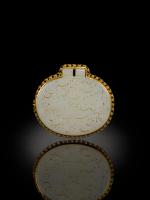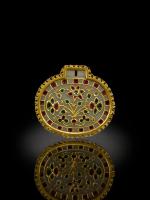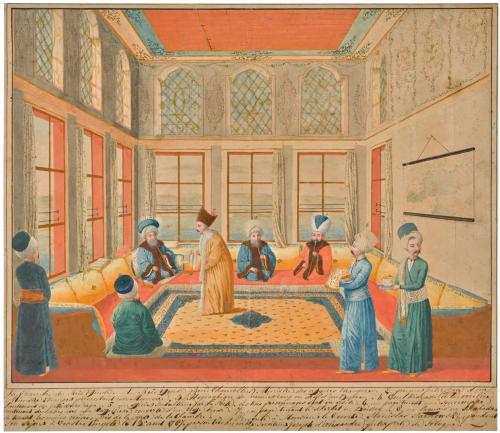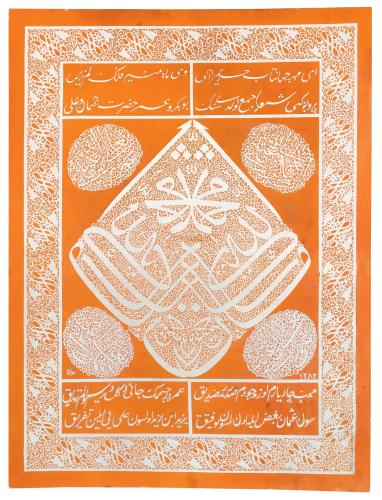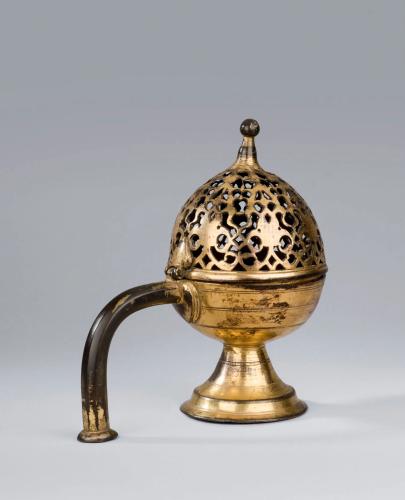
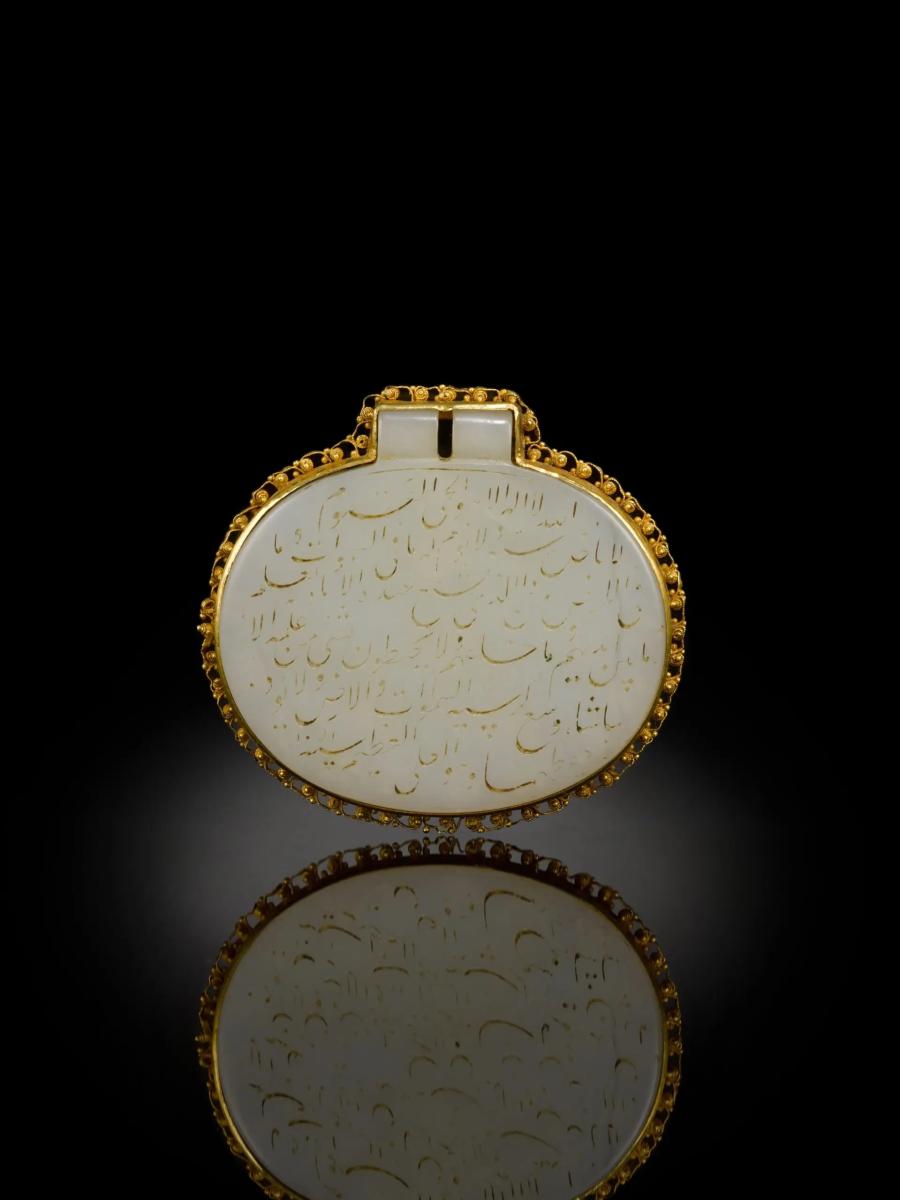
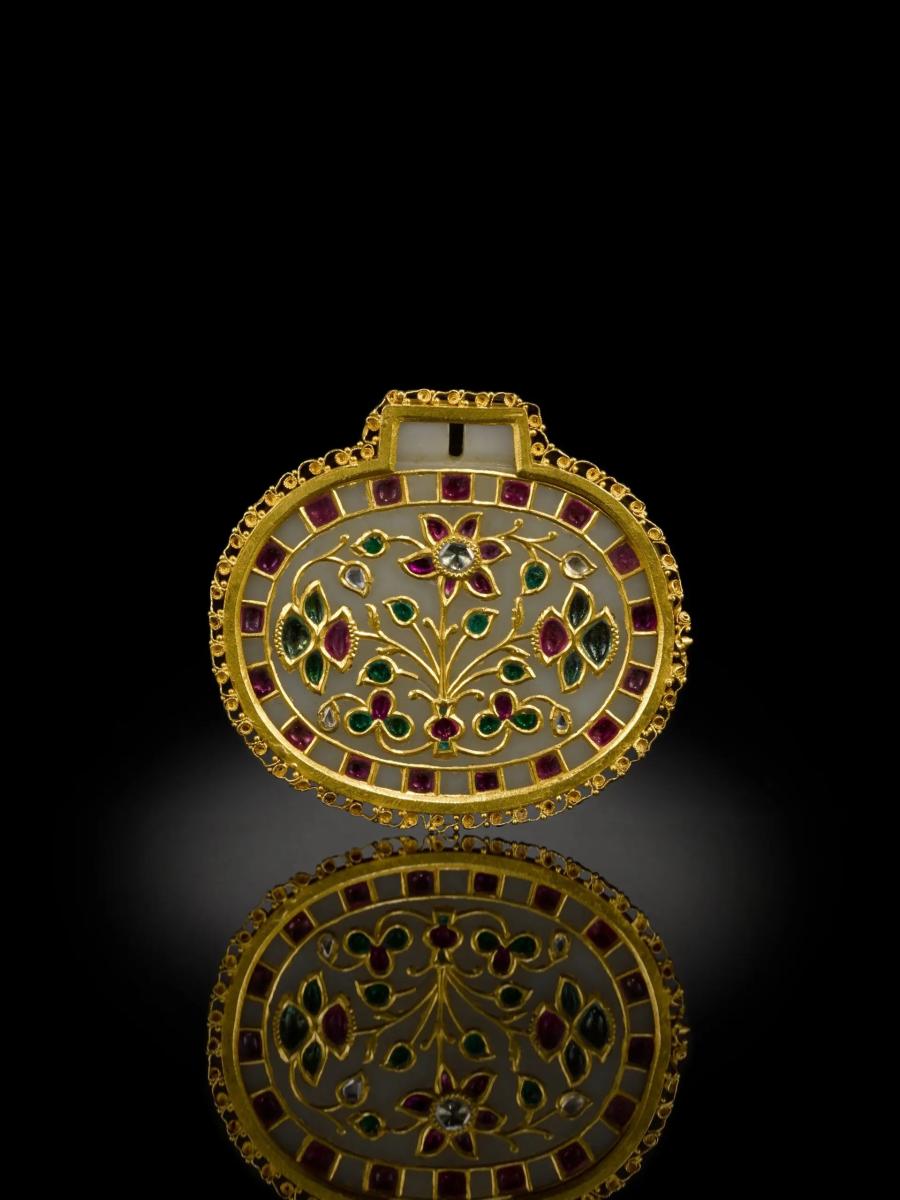
Price on application
This object is eligible for a Certificate of BADA Provenance
The BADA Standard
- Since 1918, BADA has been the leading association for the antiques and fine art trade
- Members are elected for their knowledge, integrity and quality of stock
- Our clients are protected by BADA’s code of conduct
- Our dealers’ membership is reviewed and renewed annually
- Bada.org is a non-profit site: clients deal directly with members and they pay no hidden fees
A Magnificent Mughal Jade Pendant (Haldili) with the Throne Verse (Ayat Al-Kursi) from The Qur’an.
India.
Hight: 5 cm.
Width 6 cm.
Jade dated 1051 A.H. / 1641 C.E. Produced during the reign of the Mughal Emperor Shah Jahan (r. 1627-1658).
The Gold Frame with Set-Jewels: 19th Century.
Of oval form with suspension loop to the upper edge, in openwork gold mount, the front engraved with an extremely fine, imperial quality nasta’liq inscription, the back inlaid with diamonds, emeralds and rubies in kundan setting forming a floral spray enclosed within a border of square panels, alternate squares set with rubies. The gold frame and gem-set decoration on the back was executed in the 19th Century.
The pendeant has the Throne Verse (Ayat al-Kursi) from the Qur’an (2:255) on the front.
The Arabic Text:
اللَّهُ لاَ إِلَهَ إِلاَّ هُوَ الْحَيُّ الْقَيُّومُ لاَ تَأْخُذُهُ سِنَةٌ وَلاَ نَوْمٌ لَهُ مَا فِي السَّمَاوَاتِ وَمَا فِي الأَرْضِ مَنْ ذَا الَّذِي يَشْفَعُ عِنْدَهُ إِلاَّ بِإِذْنِهِ يَعْلَمُ مَا بَيْنَ أَيْدِيهِمْ وَمَا خَلْفَهُمْ وَلاَ يُحِيطُونَ بِشَيْءٍ مِنْ عِلْمِهِ إِلاَّ بِمَا شَاءَ وَسِعَ كُرْسِيُّهُ السَّمَوٰتِ وَالأَرْضَ وَلاَ يَئُودُهُ حِفْظُهُمَا وَهُوَ الْعَلِيُّ الْعَظِيمُ
The Translation:
“Allah! There is no deity but Him, the Alive, the Eternal. Neither slumber nor sleep overtakes Him. Unto Him belongs whatsoever is in the heavens and whatsoever is in the earth. Who could intercede in His presence without His permission? He knows that which is in front of them and that which is behind them, while they encompass nothing of His knowledge except what He wills. His throne includes the heavens and the earth, and He is never weary of preserving them. He is the Sublime, the Tremendous.”
The fine nasta’liq calligraphy of the present plaque owes a debt to the Persian tradition which played an important role in the genesis of Mughal art. Despite the technical challenges of carving text into a hardstone, the calligraphy is absolutely masterful, even when studied under close magnification. The strength and precision of the execution, as well as the use of high-quality white jade, points towards royal patronage at a time when Shah Jahan was at the head of the Mughal Empire.
A comparable Mughal jade pendant with the Throne Verse, dated 1006 A.H. / 1597 A.D., was sold at Christie’s London, in 10 April 2014, for £290,500.
The Mughal Emperors and members of the palace circle inherited the Timurid rulers’ love of jade, and quickly developed their own jade carving craft on the foundations of the hardstone sculpting artistic tradition already firmly established in India. The early Mughal jade carvings were relatively plain but the fourth Mughal Emperor Jahangir and his son, the fifth Emperor Shah Jahan, under whom the present piece was produced, were great patrons of jade carving. For further information please see, Teng Shu-ping et al, Treasures from Across the Kunlun Mountains: Islamic Jades in the National Palace Museum Collection, National Palace Museum Taiwan, Taipei, 2008, p. 85. A jade plaque similarly decorated with a gem-set motif is published in U.R. Balakrishnan & M. Sushil Kumar, Dance of the Peacock: Jewellery Traditions in India, Bombay, 2001, p.255, no.414.
The set-jewels on the reverse of this jade pendant depict spring flowers in a vase. ‘Flowers in a vase’ is an important motif widely used in Islamic and Indian art. In Indian culture, flowers were a constant part of daily life, grown in gardens everywhere, from palaces to humble homes. Flowers were blessed reminders of the gardens of heaven. Foreign travellers and ambassadors who visited the Mughal Empire frequently remarked about this love of flowers. For further information about ‘Flowers in baskets or vases’ motifs please see, Motif from the Sadberk Hanım Museum Collection (written by Turgut Saner, Şebnem Eryavuz and Hülya Bilgi), Sadberk Hanım Museum, Istanbul, 2020, pp. 110-111.
For pendants with the Throne Verse in the British Museum, please see Venetia Porter, Arabic and Persian Seals and Amulets in the British Museum, The British Museum, London, 2011, pp. 164-165.
This magnificent pendant, dated AH 1051 / AD 1641-42, is an extremely rare jade of imperial quality, produced during the reign of the Mughal Emperor Shah Jahan (r. 1627-1658).
Provenance
Ex-Private English Collection, London.
The BADA Standard
- Since 1918, BADA has been the leading association for the antiques and fine art trade
- Members are elected for their knowledge, integrity and quality of stock
- Our clients are protected by BADA’s code of conduct
- Our dealers’ membership is reviewed and renewed annually
- Bada.org is a non-profit site: clients deal directly with members and they pay no hidden fees


